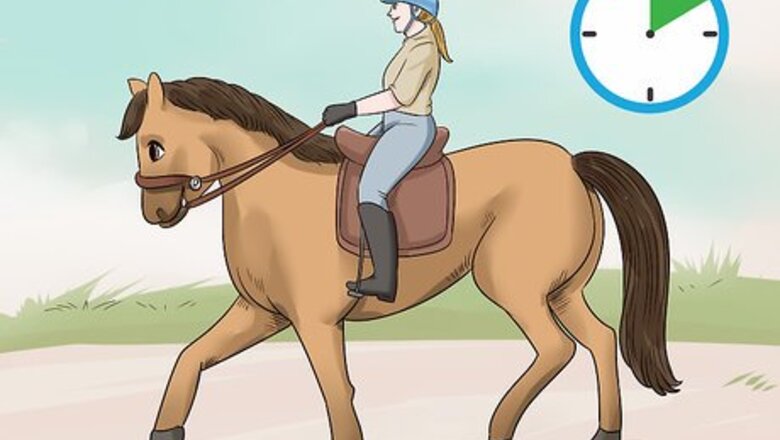
views
Shifting into a Gallop
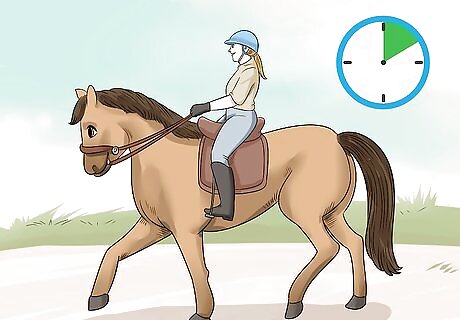
Ride the horse at a walk or trot for at least ten minutes. Before you allow the horse to begin galloping you need to get it warmed up. This will enable the horse to stretch out its body in preparation for swift movement. Also, a warmup period will help you familiarize yourself with the horse's personality and signals. This will help communication with the horse throughout your ride. Make sure to take some time to get comfortable with the arena footing. Also, check for any obstacles in the arena or any distractions or things that could spook your horse outside the arena, such as tarps or other horses.

Pick up speed slowly. Rather than forcing the horse to go up to a gallop immediately, transition gradually into a gallop. That way, you can continually adjust your position until you are in a perfect 2-point position. Get your horse to canter in 2-point. Once it is steady, urge your horse to go faster into a gallop. Use your leg pressure and the reins to encourage your horse to go faster as you transition from a canter to a gallop.
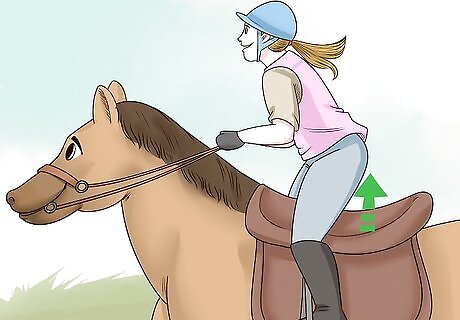
Begin to stand up in your stirrups as you ease into a gallop. As your horse picks up speed, move forward and shift your weight onto the balls of your feet. The goal is to move your weight forward enough so that you can eventually hold your rear end above the seat of the saddle. However, you don't want to move so far forward that you risk falling forward if the horse slows down. Your weight needs to be rooted in your pelvis rather than your shoulders. Keeping your weight low will allow you to maintain your balance more easily. Keep your heels down and your toes up. Staying in this position will help to keep your weight balanced and back on the saddle. This is also a safer position if your horse stops suddenly.
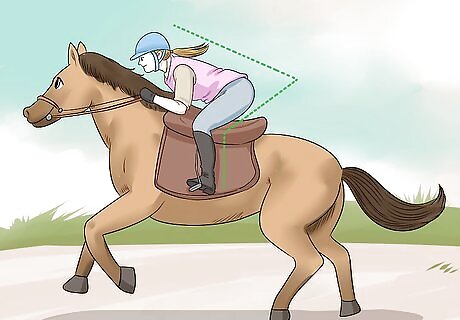
Move into a proper 2-point position. This position allows you to keep your weight suspended over the horse's back, rather than bouncing on it repeatedly. To get into 2-point position, lean forward and hold the horse's mane, which helps you keep your balance without using the reins for balance. Keep your seat-bones pointing down towards the saddle. Your abdominal muscles should be contracted, so you don't push your lower back out. This will help keep your back straight rather than allowing it to round forward. When trying to picture how your body should be positioned, think of someone who is downhill skiing on moguls. If the gallop positioning doesn't turn out the way you would like the first time, don't be discouraged. A perfected gallop takes balance and practice. Not to mention patience.
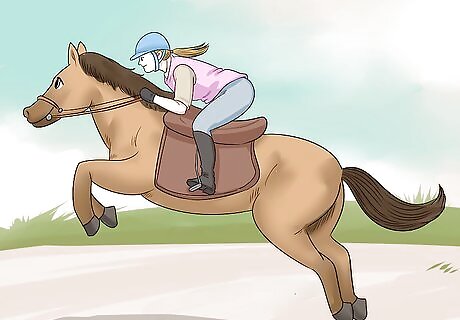
Maintain proper positioning as your horse gallops. As your horse gallops you will need to focus your energy on maintaining good positioning. Keeping your rear end elevated off the saddle will allow the horse to gallop easier and it will minimize the risk of your horse getting a back injury due to your body weight bouncing in the saddle. Your upper body and head will remain stable while your arms and legs will be absorbing the movements of the horse. If you are doing this correctly and your horse stumbles, you will sit down automatically and get deeper in the saddle rather than pitching forward towards the horse's neck.
Building Up to a Gallop
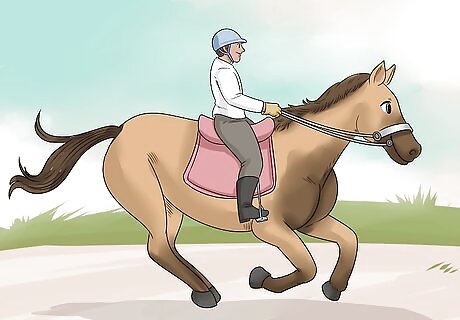
Get comfortable with cantering. You must be able to control your horse and feel happy in a canter before attempting to gallop. Practicing a horse's other gaits will allow you to naturally build up to proper galloping positioning. A canter is basically a slow run for a horse. It is faster than a trot but not the full-out run of a gallop.
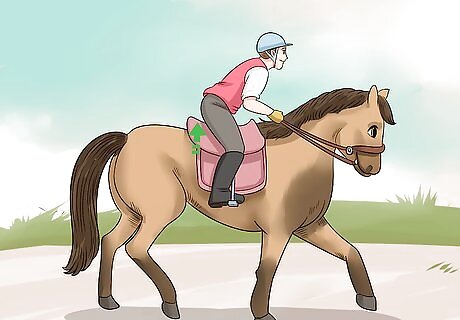
Practice standing up in your stirrups. In order to keep on your horse while it is galloping, you will need to be able to stand up in the stirrups. So, when you are riding your horse at a trot or canter, you should practice standing up in the stirrups. Practicing standing up in the stirrups will help you build up the muscles you will need to hold this position while the horse is galloping. You can also drop your stirrups and hold a seated trot. This will help to strengthen your legs and help your 2-point.

Perfect the 2-point position while riding at a lower speed. Keep practicing the 2-point position at a slower gait, such as a canter. It is important to know you have the strength and muscle stamina to keep your body elevated above the horse before you try to do it while galloping. Perfecting your 2-point positioning will likely take a lot of practice. You will need to get used to the proper body positioning and the energy it takes to hold that position. A horse may be able to gallop for a long amount of time, but you must be sure you're prepared for this. Always remember that not only does the horse become exhausted, but the rider as well. It is just as dangerous to push yourself as it is to push the horse because your exhaustion could easily lead to you losing control.
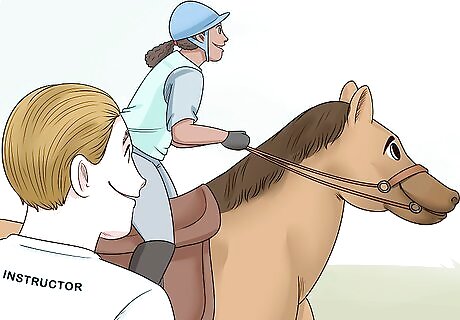
Consider hiring an instructor. To perfect your 2-point position and to build up to a gallop, you may want to find a riding instructor to help you. A riding instructor can assess your positioning and can instruct you about how to improve your riding. A good riding instructor can typically be found by searching online or through your local riding club or horse organization.
Galloping Safely

Wear safety equipment. There are a variety of products that you can use to protect your safety while riding a horse. For example, helmets and pads can really help if you do end up losing your balance or are bucked off. Wearing safety equipment is especially important when learning a new technique or riding skill, as you are more likely to get injured when doing something new. Avoid using equipment that is too old. Some items lose their safety rating after a few years, such as helmets.

Find an appropriate space where you can gallop your horse. Verify that the area you are using contains nothing dangerous in it. Check for holes and anything else that your horse could trip on. You also need a lot of space, as a galloping horse can more a long distance in a short period of time. This is important because it can sometimes be hard to stop the horse while it is galloping, especially if it isn't extremely well-trained. A riding arena is not large enough to practice galloping in. You must find a bigger space. Consider going to a good-sized hill, as it is safer to gallop uphill. One reason for this is that it is harder for the horse to trip while going uphill. Although most horses will stop on their own before the edge of a cliff or anything like that, you don't want to take any chances.
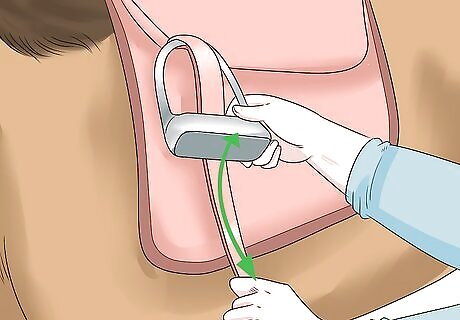
Adjust the stirrups. You want to adjust the stirrups so that you are able to stand up in the stirrups and clear the saddle. It may be counter-intuitive, but shorter stirrups actually provide a more secure position, as they encourage your heels to sink down. This is assuming you aren't riding bareback.


















Comments
0 comment